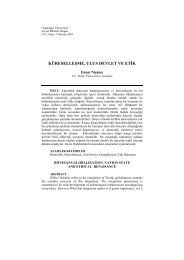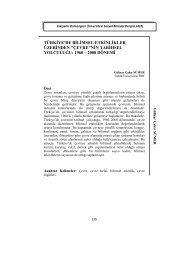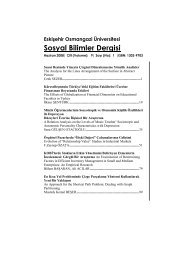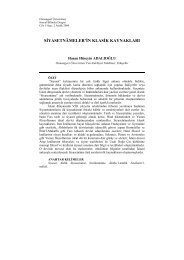image of muslim turks on the restoration stage - Eskişehir ...
image of muslim turks on the restoration stage - Eskişehir ...
image of muslim turks on the restoration stage - Eskişehir ...
Create successful ePaper yourself
Turn your PDF publications into a flip-book with our unique Google optimized e-Paper software.
B. Ayça ÜLKER ERKAN<br />
<strong>Eskişehir</strong> Osmangazi Üniversitesi Sosyal Bilimler Dergisi, 11(2)<br />
hatred, toward Islam as an outlandish competitor . . .” (Said, “Arabs,<br />
Islam” 1105).<br />
The Orient and Orientals were always in <strong>the</strong> positi<strong>on</strong> <str<strong>on</strong>g>of</str<strong>on</strong>g> “outsiders” and<br />
were c<strong>on</strong>sidered to be <strong>the</strong> weak partners for <strong>the</strong> West. This displacement<br />
made Orientals as aliens, backward, <strong>the</strong> “o<strong>the</strong>rs”, and as standing in <strong>the</strong><br />
peripheral world <str<strong>on</strong>g>of</str<strong>on</strong>g> Western hegem<strong>on</strong>y. Moreover, <strong>the</strong>re was a tendency<br />
<str<strong>on</strong>g>of</str<strong>on</strong>g> Western col<strong>on</strong>ial and imperialist domini<strong>on</strong> over <strong>the</strong> Islamic world. As<br />
Said emphasized Westerners saw <strong>the</strong> Orient as a locati<strong>on</strong> requiring<br />
Western attenti<strong>on</strong>, rec<strong>on</strong>structi<strong>on</strong>, and even redempti<strong>on</strong> (“Arabs, Islam”<br />
112). The technological development, progress, and success <str<strong>on</strong>g>of</str<strong>on</strong>g> <strong>the</strong> West<br />
failed <strong>the</strong>m to comprehend <strong>the</strong> spirit <str<strong>on</strong>g>of</str<strong>on</strong>g> <strong>the</strong> Orient especially in its moral<br />
power. Still, it did not prevent Western interest in <strong>the</strong> Orient. There was<br />
an inclinati<strong>on</strong> to c<strong>on</strong>test assumpti<strong>on</strong>s <str<strong>on</strong>g>of</str<strong>on</strong>g> European politico-cultural<br />
superiority over <strong>the</strong> East. Thus, “The Eastern Questi<strong>on</strong>” basically arouse<br />
from “<strong>the</strong> efforts to prevent <strong>the</strong> Ottomans from enforcing <strong>the</strong>ir authority”<br />
(Nash 13).<br />
Louis M<strong>on</strong>trose draws attenti<strong>on</strong> to <strong>the</strong> new historicism by analyzing<br />
“o<strong>the</strong>rness” and “inclusiveness”. M<strong>on</strong>trose emphasizes <strong>the</strong> o<strong>the</strong>rness by<br />
exclusiveness; “experiences <str<strong>on</strong>g>of</str<strong>on</strong>g> exclusiveness or o<strong>the</strong>rness may, <str<strong>on</strong>g>of</str<strong>on</strong>g> course,<br />
provoke a compensatory embrace <str<strong>on</strong>g>of</str<strong>on</strong>g> <strong>the</strong> dominant culture, a desire for<br />
acceptance and assimilati<strong>on</strong> . . . provoke attitudes <str<strong>on</strong>g>of</str<strong>on</strong>g> resistance or<br />
c<strong>on</strong>testati<strong>on</strong>” (393). In <strong>the</strong> light <str<strong>on</strong>g>of</str<strong>on</strong>g> this perspective, <strong>the</strong> Western<br />
hegem<strong>on</strong>y “embraces” <strong>the</strong> Orient for assimilati<strong>on</strong>, still <strong>the</strong> Orient, namely<br />
<strong>the</strong> Ottoman Empire is an unknown exotic world, which subverts or<br />
transgresses <strong>the</strong> hegem<strong>on</strong>ic Western ideology.<br />
2. THE EASTERN QUESTION: THE DEVASTATING<br />
TURKISH IMAGE<br />
Perhaps <strong>on</strong>e should take a brief look at Turkish history and Islam in order<br />
to comprehend how <strong>the</strong> Turkish <str<strong>on</strong>g>image</str<strong>on</strong>g> is established according to <strong>the</strong><br />
Western point <str<strong>on</strong>g>of</str<strong>on</strong>g> view and how Westerns appreciated Orientalism. The<br />
<str<strong>on</strong>g>image</str<strong>on</strong>g> <str<strong>on</strong>g>of</str<strong>on</strong>g> <strong>the</strong> Turk that emerged in 1088 at <strong>the</strong> time <str<strong>on</strong>g>of</str<strong>on</strong>g> <strong>the</strong> Byzantine<br />
Emperor Alexius Comnenus was certainly a negative <strong>on</strong>e: “<strong>the</strong> <str<strong>on</strong>g>image</str<strong>on</strong>g> <str<strong>on</strong>g>of</str<strong>on</strong>g><br />
an enemy”, who was “cruel”, “barbaric”, “devastating”, as somebody<br />
who was c<strong>on</strong>sidered a ‘threat for Christianity’ (Kuran –Burçoğlu 188).<br />
First <str<strong>on</strong>g>of</str<strong>on</strong>g> all, <strong>the</strong> enmity <str<strong>on</strong>g>of</str<strong>on</strong>g> Muslim Turks flourished from <strong>the</strong> very<br />
beginning <str<strong>on</strong>g>of</str<strong>on</strong>g> <strong>the</strong> first Crusade 2<br />
. As Kuran –Burçoğlu states, <strong>the</strong> letter that<br />
2<br />
The First Crusade was a military expediti<strong>on</strong> from 1096 to 1099 by Western Christianity<br />
to regain <strong>the</strong> Holy Lands taken in <strong>the</strong> Muslim c<strong>on</strong>quest <str<strong>on</strong>g>of</str<strong>on</strong>g> <strong>the</strong> Levant, resulting in <strong>the</strong><br />
30









